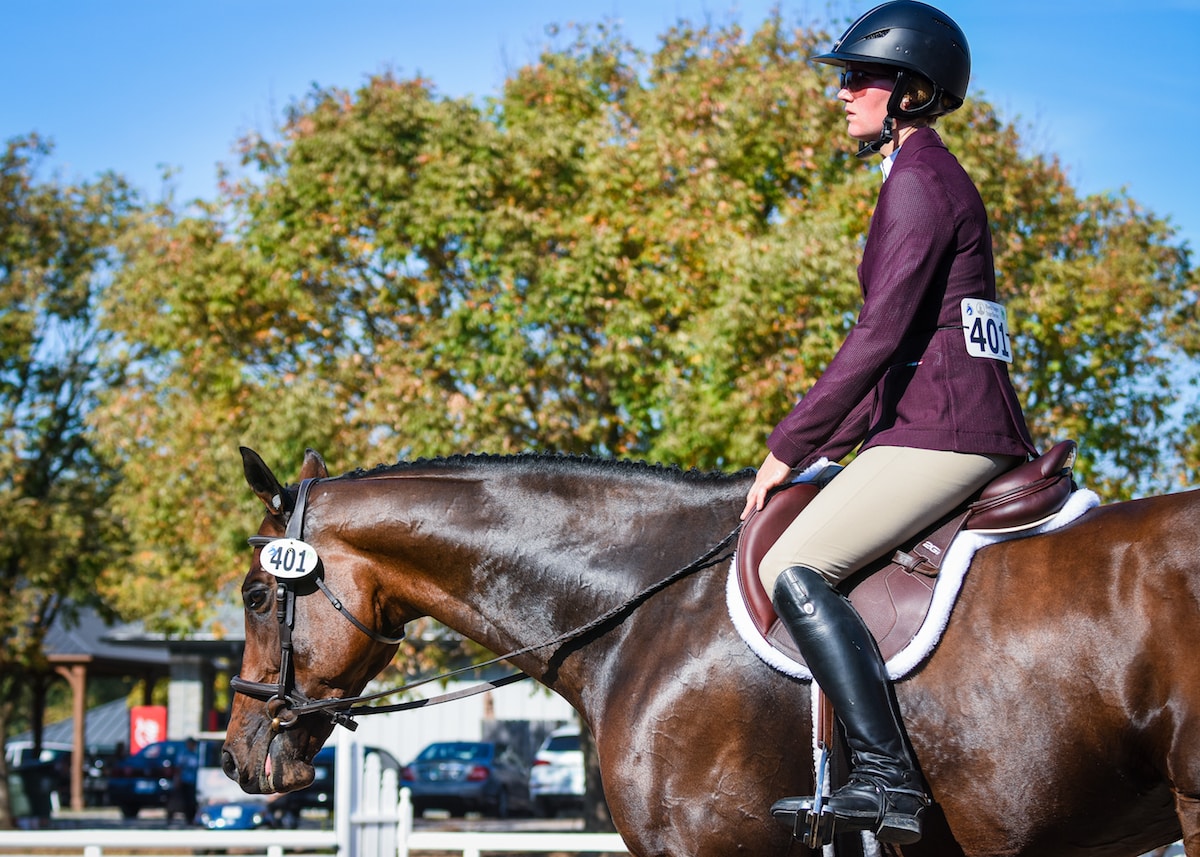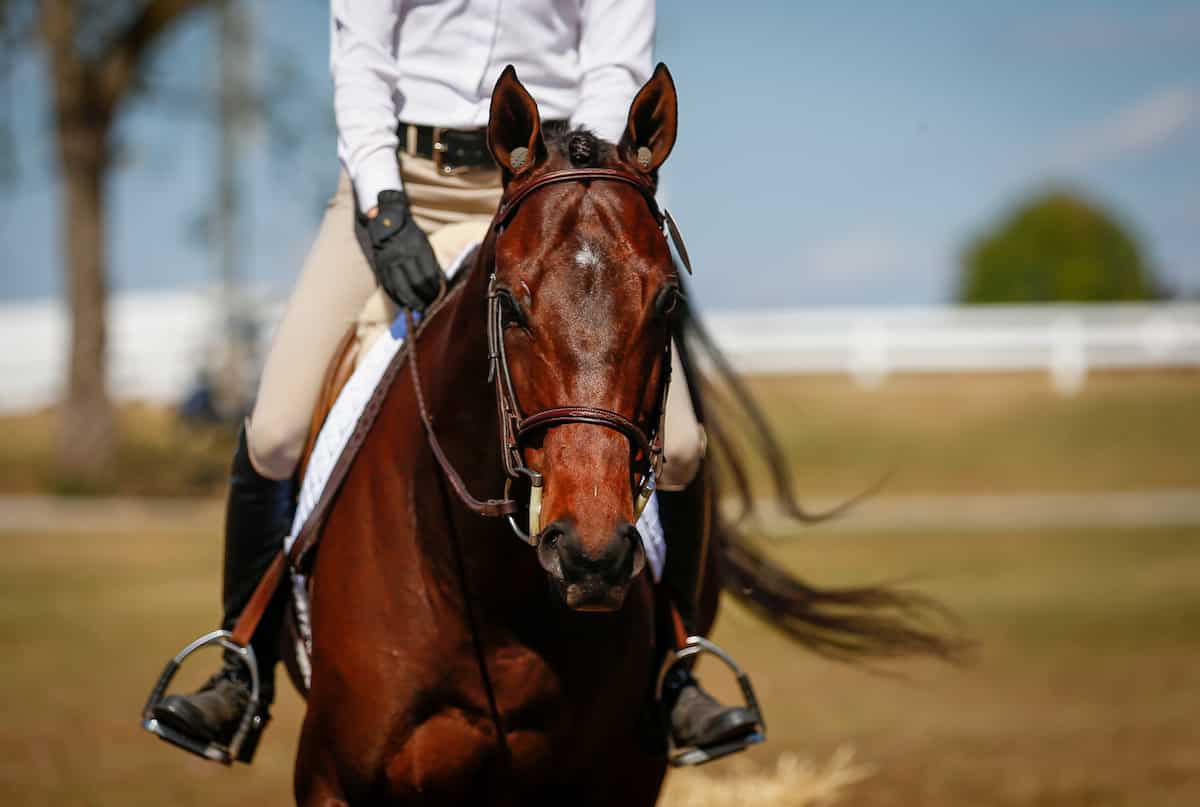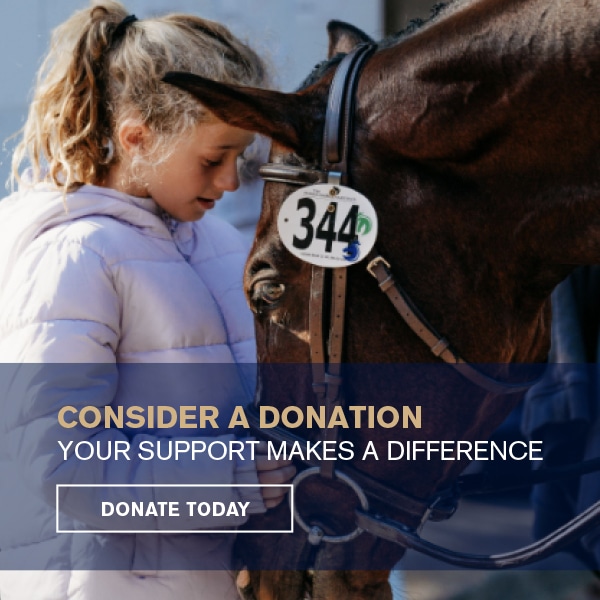Tried-and-true techniques for helping make your retired racehorse’s first show a positive one

401 Star Spangled and Mallory Greiner
When This is Me went to his first hunter show early this year, the elegant bay OTTB absolutely cleaned up, winning five of his classes. Then something unexpected happened in his sixth.
“Just as they were saying, ‘You are now being judged,’ a horse walking down the alleyway (beside the arena) spooked and took out a couple of garbage cans,” says Ryan Watson, one of three partners in RAH Bloodstock, owners of the 4-year-old gelding (Doctor Chit — Talking Audrey, Thunder Gulch) whom they call “Little Chit.”
Such a sudden disturbance in a quiet indoor arena would rattle any horse, much less a horse show newbie. But hardly a moment later Little Chit had returned to his reliable steady gait. This tempered response and the five blue ribbons before it weren’t just luck, however — the RAH team had done their homework in preparing the horse for his first show.
Retired racehorses are uniquely positioned to transition to showing, but their first time out can be intimidating to riders and horses alike. We spoke with Watson and another trainer, Mallory Richard, who, like him, works full-time in the Thoroughbred industry and owns, trains and shows OTTBs, about preparing for this milestone. Their familiarity with all stages of a Thoroughbred racehorse’s life arguably gives them a leg up on understanding how OTTBs see and process the world around them and handle new situations. Read on for their insights.
Your Racehorse’s Roots and How They Help
Watson is stallion manager at Darby Dan Farm, in Lexington, Kentucky, where he works daily with 12 illustrious former racehorses — among them 2011 Florida Derby and Holy Bull Stakes winner Dialed In and 2019 Kentucky Derby winner Country House — and two teaser studs. He has retrained two OTTBs to be show horses and many others for ranch work and trail riding and believes racehorses’ backgrounds give them second-career advantages.
“These horses are handled from the time that they literally take their first breath all the way up through the ranks (of racing),” says Watson. “They have experienced a lot in a very little amount of time. You think about what they can experience, say, on a normal average race day: It is going to be tractors and crowds and noise and kids and flags blowing and things like that. They’re taught to change leads, they’re taught to go into tight spaces, they’re taught to stand quietly in a confined space of the starting gates.”
Richard, a self-described jack of all trades in her husband’s racing operation of 20 horses in Vinton, Louisiana, agrees. “Most racehorses know how to get on a trailer and go to new places because they don’t stay at the same track their entire life,” she says. “They’re shipped several times a year, so getting on and off a trailer is never normally a big deal.”
She has taken six former racehorses to the show ring — two to the Thoroughbred Makeover — and has prepared several others for their second careers as track ponies and adult amateur mounts. For most of these horses the transition to show has been uneventful.
“I feel that people kind of make (an OTTB’s first show) more than what it is, you know?” she adds. “They’re used to seeing the vehicle traffic. They’re used to braiding; I don’t braid my horses, but there are a lot of barns that do. Most of them are very used to getting their manes pulled, bridle paths and ears trimmed and clipped,” tasks she does behind the scenes at the racetrack.
Even with the built-in desensitization and familiar routines, it still takes careful planning and patience to prepare OTTBs to perform their new, often-lower-gear jobs in unfamiliar places.

The RAH team did their homework in preparing This Is Me for his first show; the gelding was calm and reasonable. Courtesy Ryan Watson
Ahead of the Show
Richard starts by taking her OTTBs off the farm regularly, emphasizing that it’s as much about the energy she brings to the activity as her training and riding at the destination venue. “Every week Star (Star Spangled [Five Star Day — Annie Akeley, Evansville Slew]) gets on the trailer, and we drive an hour and a half away for a lesson. We ride and we come home, and I don’t make a big deal about it.”
An unseasonably wet spring and summer ended up helping Watson get off the farm when he was retraining his first Thoroughbred Makeover horse in 2018, Hard Knock Life (Awesome Again — Capeside Lady, Cape Town). Because they had no arena where they boarded and it was too wet to accomplish much in the farm fields, they’d ship “Hardy” out regularly to a nearby venue to work.
Wherever you train, be sure you consider your horse’s base fitness and work toward getting him in consistent work with regular instruction, whether that’s with a local trainer or clinicians.
“Put him into a program,” says Richard. “I feel like a lot of people halfheartedly commit to getting these horses show ready, and then they go to these shows and expect these horses to be good, only to be disappointed.”
Another great thing to do as you train at home and away is acclimate your horse to arena traffic. Thoroughbreds aren’t necessarily familiar with having ridden horses approaching them head-on at speed in a space. “Allow them to experience horses coming at them, beside them, by them, behind them, to get them as used to that as possible so that they do remain relaxed,” says Watson, reinforcing with repetition.
OTTB’s First Show
How you know it’s time? There are a few ways you can approach your horse’s first schooling show. It can be purely for experience — just to take in the atmosphere and explore the warmup rings, the grounds, watch some classes from the ground and perhaps longe. You can also enter a few classes but focus on the basics in them; for instance, if it’s a jumping class, you can trot into a fence, canter out, calmly stop, then continue. Or, you might be ready to actually compete, the way This Is Me was, despite the garbage can incident.
Richard waits for her horses to tell her when it is time to head out for that first show.
“When you start to have the same horse that you have at home … on the road, it’s safe to say you’re ready,” she says. “When you can take them out of the barn and get on them quietly at the mounting block, and they just walk off on a long rein with their head dropped and have that neutral floppy-ear look — they’re not impressed by what’s around them.
“Some horses are always a little ‘looky,’ ” she adds, “but they can still be relaxed and looky. They just need to be able to breathe and walk off flat-footed.”
Keep it simple but in motion. Both trainers believe you can accomplish as much — if not more — on the ground than in the tack at the first few shows. Whatever you do, keep them moving with a brisk walk, a longe or simply a hack around the property.
“Don’t try to get them to stand still,” says Richard. “I think that’s the No. 1 mistake with fresh OTTBs in new environments. It’s like asking a ticking time bomb to explode. On the racetrack they never are asked to stand and be patient like that. Let him move their feet. If they want to walk in a small circle, let them walk in a small circle … you’ll end up having a more relaxed horse because you’re not trying to contain a bottle rocket.”
Give them time to adjust to the grounds. At her first two shows with Star, she didn’t enter him. Instead, she walked him around, longed him and let him take in the atmosphere. “By the end of the weekend I was able to do a little lesson on him and kick him over a few jumps.”
Watson also allows his OTTBs to be spectators at their first shows. If they want to, “allow them to stand there and smell and look and listen,” says Watson. “I’ve seen horses come unglued at the first few words out of a PA system (which reminds them of the call to post or race call). If you can be in a location where they can have a chance to hear a PA system from a distance, that could mean a night-and-day difference to these horses at their first show, where every time they walk by the ring the PA system is blaring or cracking.”
Another place they can adapt to the showgrounds is in the barns. Richard always gets a day or overnight stall at shows because it gives them a place to relax and eat, and she’s found that most former racehorses don’t urinate off the farm except in a stall. She also feels it’s safer than tying to a trailer — something she trains them to do at home and on casual outings but doesn’t rely on at shows if she can help it.

Earplugs, which some Thoroughbreds race with, can help a horse relax at his first few shows. Courtesy CanterClix
Finishing Touches
Richard and Watson offer other suggestions for when you’re at your OTTB’s first few shows:
■ Don’t be afraid to try earplugs. Many horses race in earplugs, especially animals that do not relax, says Richard. She also has administered a small dose of acepromazine in her horse when he wasn’t showing, just to take off the edge and help him be more teachable.
■ Build focus with jogging/trotting forward. At Hardy’s first few shows, “we did a lot of jogging, settling in the jog, forward motion, just to keep his mind focused,” says Watson. “He didn’t have time to look around, and we repeated it until he realized he was there for a job and needed to stay focused.”
Richard has trotted her more tense hunters forward, with purpose, on 20-30-meter circles in the warmup. “Don’t give him the whole ring to build and energize from,” she says. “Then once you find him relaxed, change direction a ton. Just keep their attentiveness on you.” Calm, businesslike longe sessions can be helpful for this purpose, as well.
■ Consider simply spectating. Watson would walk Hardy up to the arena untacked, and the horse would stand and watch the other horses compete without the pressure of having a rider aboard.
■ Breathe. It can be tricky not to get caught up in the electric environment of the showgrounds. As Richard walks her OTTBs around the grounds, she talks and sings, just to keep herself breathing and the horse relaxed.
■ Go to ride your homework, not win a ribbon. If you’ve been working on preventing a left drift down your lines, for instance, focus on that during your jump rounds. Sometimes narrowing your focus to one issue can help you be a more relaxed and effective communicator with your horse, says Richard.
■ Finally, be flexible. If you had planned to stay for a full day, you might cap it at half a day if the horse has had a positive experience. Or, if it’s a weekend show and the venue is close, show one day, take him home, let him get some turnout and rest and return the next if he’s looking relaxed and happy. After all, you want your horse to associate positive experiences with showing, not soreness and fatigue.
Enjoy the Ride
Both Richard and Watson always aim to keep the big picture in focus as they prepare fresh OTTBs to show. Remember: You’re preparing them not just to compete in a single show but for the rest of their lives. Whether it’s a local fun show or the Thoroughbred Makeover, always think beyond the event, considering it a worthy steppingstone for a happy, well-adjusted and possibly decades-long second career.
Potential Showground Triggers for OTTBs
Keep an eye (and ear) out for these common situations at horse shows, remembering you’re the reasonable guide who can remain calm and help your horse accept these variables as normal. One way to do this is by exposing your horse to them one at a time prior to a show in low-key environments:
■ PA systems.
■ Strollers.
■ Golf carts or UTVs.
■ Flags.
■ Banners along an arena wall.
■ Horses passing you in the arena, whether going the same or a different direction.
■ Crowds standing close to the rail (racetrack crowds can’t get as close to working horses as show spectators can).
■ Ponies or Miniature Horses. Likewise, unfamiliar breeds — gaited, for instance — in adjacent or nearby arenas at shows can provoke reactions in OTTBs.
This article was originally published in the Spring 2021 issue of Off-Track Thoroughbred Magazine, the only publication dedicated to the Thoroughbred ex-racehorse in second careers. Want four information-packed issues a year delivered to your door or your favorite digital device? Subscribe now!

